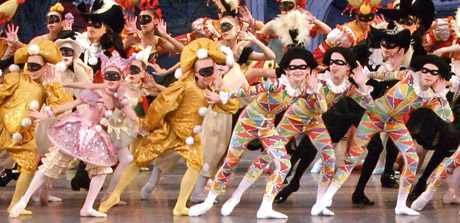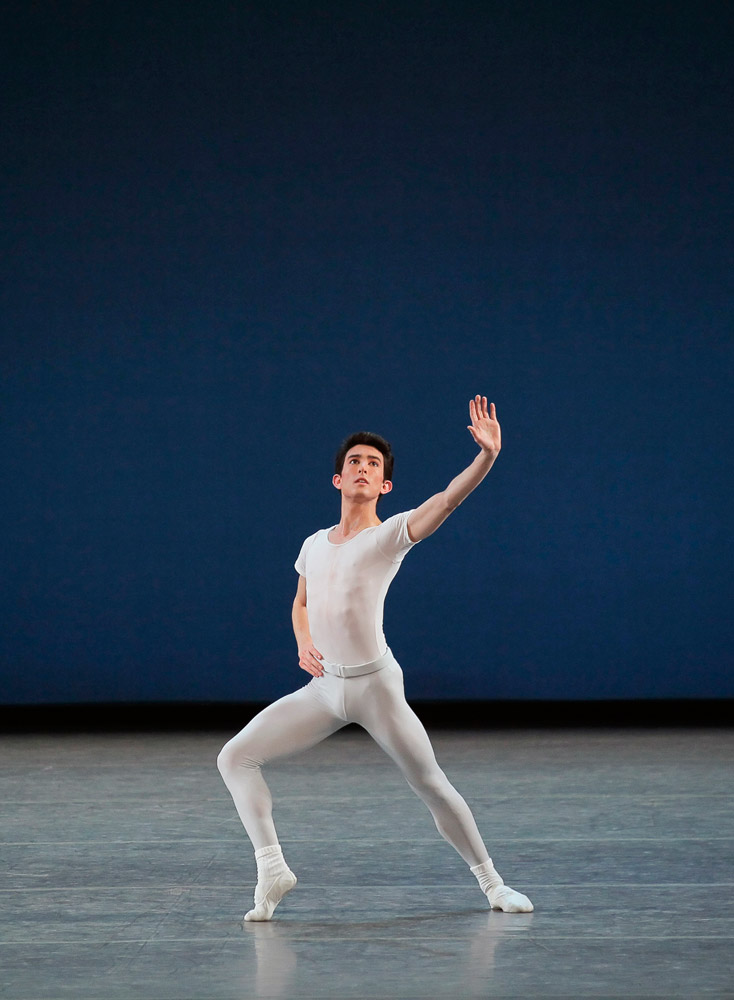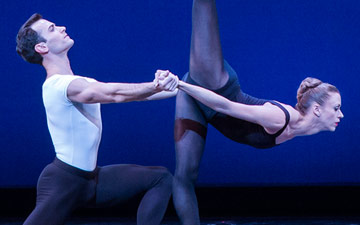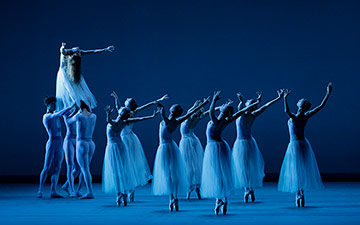
© Paul Kolnik. (Click image for larger version)
New York City Ballet
Square Dance, Harlequinade
New York, David H. Koch Theater
18 February 2015
www.nycballet.com
Throwback
Balanchine dabbled in just about every style of ballet over the course of his long and productive career, from the Art Deco modernism of The Four Temperaments to the intimacy of Liebeslieder Walzer and the splendor and wit of Symphony in C. Most often, he was creating something out of nothing, basing himself solely on the music. But from time to time he turned to a pre-existing model from the nineteenth century repertoire for inspiration. One instance was The Nutcracker, his 1954 blockbuster; twenty years later he staged the charming comedy Coppélia, basing himself on the memories of his onetime partner, Alexandra Danilova. In between, he created Harlequinade (1965), a remake of Marius Petipa’s Les Millions d’Arlequin (1900), a ballet populated by commedia dell’arte characters and set to a storybook score by Riccardo Drigo. As with The Nutcracker, Balanchine had performed the original when he was a student at the Imperial ballet school in St. Petersburg. Like the other two ballets, it is full of children.
The plot is slight. Harlequin loves Columbine, but Columbine’s father wants her to marry a wealthy (and suitably ridiculous) older gentleman. A fairy helps matters by bestowing Harlequin with a large fortune. The two young lovers are allowed to marry and everyone is happy. (The older suitor is dispatched with a kick in the tuchus.) The second act is composed of a grand divertissement for tiny Harlequins, Polichinelles, Pierrots and Pierrettes, all students from the School of American Ballet. This season, New York City Ballet is reviving this soap bubble of a ballet, with Joaquín de Luz and Gonzalo García alternating in the lead role, originally created for the fast-moving, puckish Edward Villella. The role bears Villella’s imprint: playful, dashing and a bit of a show-off. Most of all, he’s incredibly fast-moving. In Harlequin’s two main solos Balanchine seems intent on including every possible step and beaten jump, if possible all at once, with little or no transition or time to breathe. But the trick is that in order get through the obstacle course of steps, the dancer must also be incredibly precise; there’s no room for error or fuzziness. As Villella wrote in his memoir Prodigal Son, “I had to be a charmer, a bit of a devil, but also a classical dancer.”
On Feb. 18 Joaquín de Luz, still the company’s most dependable bravura male dancer, even after twelve years with the company (and a few at ABT before that), was able to pull off this arduous role cleanly and with flair, down to the gradually accelerating à la seconde turns in his final solo. He’s an efficient dancer, crisp and to the point, brilliant and precise without being a showboat. If anything, he could show off just a little bit more. The ballet needs his spark in order to keep its spirits up at a sufficiently ebullient level. There’s something not quite convincing about this Harlequinade, a hollow quality that keeps threatening to drag it down.

© Paul Kolnik. (Click image for larger version)
It certainly has its happy moments: a drunken dance in the first act for a quintet of tall soldiers, who keep stumbling and jangling their spurs. And, best of all, Harlequin’s opening serenade, accompanied by a mandolin in the orchestra. The music here is straight out of Italian operetta, and Harlequin’s body “croons” the melody just as clearly as a tenor. (There is also, inevitably, a hint of Apollo in the image of this young man strumming his mandolin.) But the first act drags; the commedia figures are unconvincingly drawn, more Balanchine technicians than characters out of popular theatre. And the choreography, particularly for the ensembles – dressed up in super-bright, pom-pommed clown outfits – is among Balanchine’s most generic. (The cartoonish designs are by Rouben Ter-Arutunian, the man behind Union Jack and Coppélia. They’re pretty, but you can’t help feeling sorry for the people wearing them.)
The character of Colombine, in particular, lacks definition. We know within a few measures exactly what kind of girl Swanilda is in Coppélia, but who is this Colombine? Is she playful or a tease, blowing kisses every which way, but pulling back every time Harlequin draws near? In the second act she dances an enigmatic solo, punctuated by whirling turns and florid port de bras; it’s reminiscent of the private soliloquy in Emeralds, not what one expects in a light, bubbly ballet like Harlequinade. In any case, Tiler Peck has made the decision not to play Columbine as anything resembling a soubrette. She dances the role with lushness and a touch of grandeur, thus rendering her Columbine all the more remote. The dancing is beautiful, but doesn’t belong in this ballet.
As the supporting players Pierrette and Pierrot, Erica Pereira and Daniel Ulbricht are elegant and bright but slightly pallid. Pereira’s dancing has sparkle and child-like lightness, but lacks inflection. Ulbricht, relegated to second fiddle and wearing voluminous sleeves and a mask, seems deflated, going through the motions without his usual affable charm. There’s something dutiful about all the mime and storytelling in this act, with the exception of the Robert La Fosse’s flowery turn as Columbine’s wealthy, big-bellied elderly suitor.
Things improve considerably in the second act, once the story has been dispensed with. Emily Garrity, as the fairy who changes Harlequin’s fortunes, executes the role’s slow, gooey arabesques and dips (penchés) with great control and fullness, as if moving through something thicker than air. A skein of birds – led by a vivacious Lauren King – prances and flutters like a chorus-line at the Folies Bergère. But mostly the act consists of dances for the kids, tiny versions of the adult characters: a giant polonaise full of interweaving lines; a Charlie Chaplin step for the miniature Harlequins, leggy as grasshoppers; shuffling, drooping steps for the Pierrots in their long sleeves. As always when students from the School of American Ballet are involved, it’s impossible not to be delighted (and impressed) by how well they’ve been prepared, how musical and precise and quick they all are. The show belongs to them as much as it does to Harlequin.

© Paul Kolnik. (Click image for larger version)
If Harlequinade is somewhat less than the sum of its parts, Square Dance (1957), which preceded it on the program, never fails to lift the heart. Set to music by Corelli and Vivaldi, the ballet was meant to highlight parallels between English and American country dancing and classical ballet: the order, the good humor, the sense of friendliness and good manners. (At one time, it even included a square dance caller.) It’s an example of Balanchinean economy: just a few steps – emboités, soutenus, hops – held up to the light and used for maximum effect. Everything is repeated, usually many times. The men dance for the women, the women for the men. Groups engage in games of follow-the leader. The dancers walk forward and back, and cross over from left to right and right to left. The ballet is almost transparent in its apparent simplicity.
On this night, the leaders of this orderly assembly were Ashley Bouder and Anthony Huxley. Bouder, a brilliant technician, has a way of arriving at a position just slightly ahead of the note, the better to hold it just a moment longer. It gives her dancing a punchy feel, hard rather than relaxed, all the more so when, as in this performance, she accessorizes the steps with coy looks at the audience. Huxley, on the other hand, hasn’t yet found a way of unleashing his personality onstage. He is a tremendously elegant dancer, with extraordinarily smooth transitions, a creamy legato. But he seems to dance mostly for himself – there’s little connection with his partner or anyone else. And, without that connection, some of the good humor that makes this ballet such a joy is inevitably lost.

















You must be logged in to post a comment.